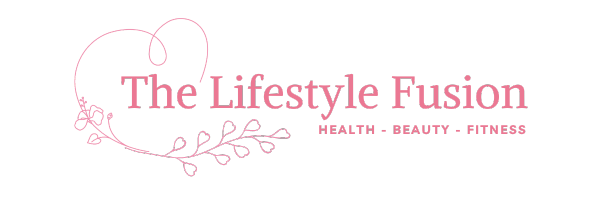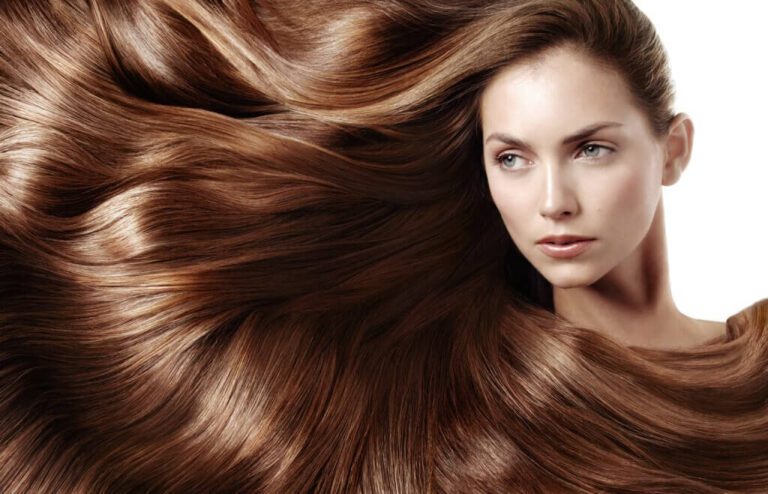The science behind hair growth encompasses a complete hair growth cycle, factors affecting hair growth, common myths and misconceptions, and remedies to promote hair growth. Assuredly, this hair growth subject will be enjoyable and informative to you. So let’s get started!
Understanding hair growth is essential for holistic self-care, extending beyond cosmetic concerns. It serves as a mirror reflecting our overall health and well-being. The knowledge of the science behind hair growth allows us to identify potential health issues, as disruptions may signify underlying problems. Recognizing the influence of genetics, hormones, and nutrition on hair growth empowers us to make informed lifestyle choices. Healthy hair growth is not just about appearance; it is indicative of internal balance and vitality. By comprehending the science behind hair growth, we gain insights into our body’s functioning and can address potential deficiencies. Effective hair care practices are rooted in an understanding of the factors influencing growth, ensuring a proactive and tailored approach. In essence, understanding hair growth is a key aspect of proactive health management, enabling us to nurture both our internal and external well-being.
The science behind hair growth is a captivating journey into our body’s intricate mechanisms. Hair growth is cyclical, involving phases like Anagen, Catagen, Telogen, and Exogen, each with a specific role in the process. Genetic factors play a significant role in determining the characteristics of our hair, from texture to growth patterns. Hormones, particularly androgens and estrogen, influence the pace and quality of hair growth. Nutritional elements, including vitamins and minerals, are essential contributors to robust hair growth. Scalp health is a critical factor, as a nourished scalp fosters optimal conditions for hair growth. The science helps us understand how stress and environmental factors can impact hair health. Hair growth is a dynamic reflection of our overall well-being and internal balance. The intricate interplay of biological processes underscores the importance of holistic care for vibrant and healthy hair. Embracing this knowledge empowers individuals to make informed choices for effective and personalized hair care routines.
– The Hair Growth Cycle
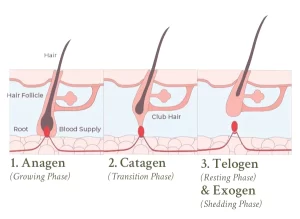
1. Anagen Phase:
The Anagen Phase of the hair growth cycle is a crucial and dynamic period characterized by active hair growth. During this phase, the hair follicles are in a state of constant activity, producing new cells that eventually form the hair strand. This phase typically lasts for several years, and the duration is largely determined by genetics, influencing the length to which an individual’s hair can grow. Cells in the hair bulb rapidly divide, leading to the formation of the hair shaft. What makes the Anagen Phase fascinating is that it is a period of vitality, during which the hair is at its healthiest and most resilient. The rate of growth can vary among individuals, but on average, hair grows about half an inch per month. External factors such as nutrition, hormonal balance, and overall health can influence the efficiency and duration of the Anagen Phase. Understanding and optimizing this growth stage is essential for maintaining healthy and vibrant hair, making it an integral aspect of any comprehensive hair care routine.
2. Catagen Phase:
The Catagen Phase, a transitional period in the hair growth cycle, follows the Anagen Phase and precedes the Telogen Phase. This brief but crucial stage marks a temporary slowdown in hair growth. During Catagen, the hair follicle undergoes a series of structural changes, including the contraction of the hair shaft and the detachment of the hair from its blood supply. This phase typically lasts for a few weeks, a natural transition that allows the hair follicle to renew itself. While the hair is no longer actively growing during Catagen, it is important to note that this phase is not a signal of hair loss; rather, it is a necessary part of the continuous cycle of hair growth and renewal. The Catagen Phase plays a vital role in ensuring that the hair follicles remain healthy and capable of producing new hair strands in the subsequent Anagen Phase. Although it is a relatively short period in the overall cycle, understanding Catagen provides insights into the dynamic and self-renewing nature of the hair growth process.
3. Telogen Phase:
The Telogen Phase is a significant stage in the hair growth cycle, representing a resting period for the hair follicles. Following the Catagen Phase, during which the hair follicle undergoes structural changes, the Telogen Phase is characterized by relative inactivity. It is a time when the hair strand is fully formed but not actively growing. Lasting for several weeks to a few months, this phase allows the hair follicle to rest and prepares for the eventual shedding of the old hair. It’s important to note that a substantial percentage of our hair follicles are in the Telogen Phase at any given time. While the hair in this phase may seem static, it is a temporary pause before the cycle recommences. Environmental factors, stress, and hormonal changes can influence the duration of the Telogen Phase. Shedding during this period is a natural part of the hair renewal process, allowing new hair growth. Understanding the Telogen Phase provides insight into the balance and renewal mechanisms inherent in the hair growth cycle, emphasizing the dynamic nature of healthy hair.
4. Exogen Phase:
The Exogen Phase is the concluding stage of the hair growth cycle and is characterized by the natural shedding of hair. This phase follows the Telogen Phase, during which the hair follicle rests. While in the Exogen Phase, the old hair shaft is released from the scalp, making way for new hair growth in the subsequent Anagen Phase. Shedding is a natural and continuous process, and the majority of hair loss occurs during this phase. It’s important to understand that normal hair shedding ranges from 50 to 100 hairs per day, and this phase ensures that the hair growth cycle remains in balance. Factors such as hormonal changes, stress, and environmental influences can impact the rate of shedding during the Exogen Phase. However, it’s crucial to differentiate between regular shedding and excessive hair loss, which may be indicative of underlying health issues. Appreciating the Exogen Phase sheds light on the body’s ability to renew and maintain a healthy hair growth cycle, emphasizing the cyclical nature of hair health and the continual process of regeneration.
– Factors Affecting Hair Growth
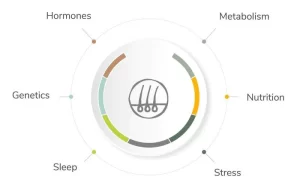
1. Genetics:
Genetics plays a pivotal role in determining various aspects of hair growth, influencing factors such as hair texture, color, and pattern of growth. The genetic code inherited from our parents largely determines the characteristics of our hair follicles, which, in turn, shape the overall quality of our hair. For example, if both parents have a certain hair texture or pattern of baldness, there’s a higher likelihood of those traits being passed down to their offspring. Specific genes control the duration of the Anagen Phase, dictating how long an individual’s hair can grow before transitioning to the Catagen Phase. Genetic factors also contribute to the density of hair follicles on the scalp. Understanding the genetic component of hair growth is crucial because it establishes a baseline for what to expect in terms of hair characteristics and growth patterns. While genetics predetermine certain aspects, lifestyle, and environmental factors can still influence the expression of these genetic traits. Consequently, a comprehensive approach to hair care considers both genetic predispositions and external influences for maintaining optimal hair health.
2. Hormones:
Hormones play a significant role in influencing the complex process of hair growth. Androgens, a group of male sex hormones that includes testosterone, and estrogen, a female sex hormone, have profound effects on the hair follicles. Androgens, particularly dihydrotestosterone (DHT), can shorten the Anagen Phase and lead to the miniaturization of hair follicles, contributing to conditions like male and female pattern baldness. Hormonal changes during life stages such as puberty, pregnancy, and menopause can also impact the hair growth cycle. For instance, elevated estrogen levels during pregnancy often lead to thicker and fuller hair, while postpartum hormonal shifts can result in temporary hair loss. Hormonal fluctuations related to thyroid disorders can influence the Anagen and Telogen Phases, affecting both hair growth and shedding. Additionally, conditions like polycystic ovary syndrome (PCOS) can cause an excess of androgens, contributing to issues like hirsutism and male-pattern hair thinning in women. Recognizing the role of hormones in hair growth is crucial for understanding and managing conditions related to hair health, allowing for more targeted approaches to treatment and care.
3. Scalp Health:
Scalp health is a fundamental factor influencing the growth and overall health of hair. The scalp serves as the foundation for hair follicles, and its condition directly impacts the ability of follicles to produce strong, vibrant strands. A clean and well-nourished scalp creates an optimal environment for hair growth. Conditions like dandruff, excess oiliness, or fungal infections can hinder hair growth by disrupting the normal functioning of hair follicles. Proper circulation in the scalp is vital, as it ensures that hair follicles receive an adequate supply of oxygen and nutrients. Regular scalp massages can stimulate blood flow, promoting a healthy environment for hair growth. Conversely, a stressed or poorly maintained scalp can lead to inflammation, follicle damage, and hair loss. Maintaining a balanced scalp pH and adopting good hygiene practices contribute to the prevention of conditions that may impede hair growth. Recognizing the symbiotic relationship between scalp health and hair growth emphasizes the importance of a holistic approach to hair care, wherein attention to the scalp becomes a crucial component for achieving and sustaining optimal hair health.
4. Nutritional Factors:
Nutritional factors play a crucial role in influencing the science behind hair growth. Hair follicles, like other rapidly dividing cells in the body, require a range of essential nutrients to function optimally. Proteins, especially keratin, are the building blocks of hair, and inadequate protein intake can lead to weakened and brittle strands. Iron, zinc, and vitamins, particularly biotin, vitamin A, and vitamin E, are essential for maintaining a nourished scalp and promoting hair growth. Deficiencies in these nutrients can result in hair thinning and loss. Omega-3 fatty acids, found in abundance in fish and certain seeds, contribute to scalp health and hair density. Additionally, antioxidants protect hair follicles from oxidative stress, which can contribute to premature hair aging and thinning. A well-balanced diet rich in fruits, vegetables, lean proteins, and whole grains provides the necessary nutrients for healthy hair growth. Recognizing the connection between nutrition and hair health underscores the importance of a wholesome diet in maintaining vibrant and resilient hair.
– How to Promote Healthy Hair Growth?
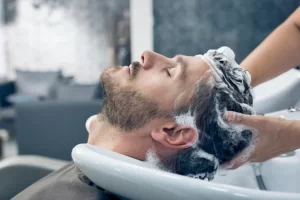
1. Proper Hair Care Practices:
Adopting proper hair care practices is integral to promoting optimal hair growth and maintaining overall hair health. Firstly, a gentle and consistent washing routine with a mild shampoo helps cleanse the scalp of dirt and excess oils, fostering a clean environment for hair follicles. Conditioning with a suitable product based on hair type and needs provides necessary moisture and minimizes breakage. Avoiding excessive heat styling and minimizing the use of chemical treatments prevents damage to the hair shaft, allowing it to grow without unnecessary stress. Regular trims help eliminate split ends, ensuring that the hair remains strong and less prone to breakage. Scalp massages, performed with gentle pressure, enhance blood circulation, promoting nutrient delivery to the hair follicles. Protective hairstyles can safeguard hair from environmental stressors and minimize friction-related damage. Additionally, using wide-tooth combs to detangle wet hair and opting for satin or silk pillowcases reduce mechanical stress on hair strands. Overall, a thoughtful and holistic approach to hair care practices contributes to an environment conducive to healthy hair growth, minimizing factors that could impede the natural hair growth cycle.
2. Scalp Massages:
Scalp massages are a simple yet effective technique to promote hair growth by enhancing blood circulation and nourishing the hair follicles. The gentle, circular motions of a scalp massage stimulate the blood vessels beneath the skin, increasing the flow of oxygen and nutrients to the hair follicles. This improved circulation helps in the efficient delivery of essential nutrients, promoting a healthier scalp environment for robust hair growth. Scalp massages also aid in the relaxation of the surrounding muscles and tissues, reducing stress and tension. Lowering stress levels is particularly important because chronic stress can contribute to hair loss. The mechanical stimulation from a scalp massage can additionally help in the distribution of natural oils, preventing the scalp from becoming too dry or too oily. Incorporating essential oils or a nourishing oil, such as coconut or jojoba oil, into the massage can enhance the benefits by providing additional nutrients and promoting overall scalp health. Regular scalp massages, whether done manually or with the assistance of a massage tool, offer a therapeutic and holistic approach to maintaining a conducive environment for healthy hair growth.
3. Nutritional Strategies:
Nutritional strategies play a crucial role in promoting hair growth by providing the essential building blocks and nourishment needed for healthy hair follicles. A well-balanced diet that includes a variety of nutrients is fundamental. Proteins, found in sources like lean meats, eggs, and legumes, are critical for the formation of keratin, the main structural component of hair. Iron in red meat, spinach, and lentils is essential for oxygen transport to the hair follicles, promoting their proper function. Biotin, present in foods like eggs, nuts, and avocados, is a key vitamin associated with hair health. Omega-3 fatty acids, found in fatty fish, flaxseeds, and walnuts, contribute to scalp health and may help reduce inflammation, supporting a favorable environment for hair growth. Vitamins A and E, obtained from fruits, vegetables, and nuts, act as antioxidants that protect hair follicles from oxidative stress. It’s also important to stay adequately hydrated as water is essential for overall bodily functions, including hair growth. While a well-rounded diet is the foundation, in some cases, supplements can be considered under the guidance of a healthcare professional to address specific nutrient deficiencies. The science behind hair growth depends on the maintenance of a nutritious and well-hydrated lifestyle that supports the body’s natural ability to grow and sustain healthy hair.
4. Lifestyle Factors:
Lifestyle factors play a significant role in promoting hair growth and maintaining overall hair health. Managing stress is paramount, as chronic stress can contribute to hair loss. Incorporating stress-reducing activities such as regular exercise, meditation, or yoga can positively impact both mental well-being and hair health. Sufficient sleep is also crucial, as the body undergoes repair and regeneration during rest, which includes the growth and maintenance of hair. Avoiding excessive heat styling and tight hairstyles reduces the risk of damage to the hair shaft, preventing breakage and promoting overall hair strength. Protecting the hair from harsh environmental factors, such as sun exposure and pollution, by using hats or scarves contributes to the prevention of damage. Additionally, refraining from smoking and excessive alcohol consumption supports general health, which in turn reflects on the condition of the hair. Adopting a healthy lifestyle, including a balanced diet, regular exercise, proper hydration, and adequate sleep, collectively fosters an environment conducive to optimal hair growth and vitality.
– Common Myths and Misconceptions

1. Dispelling Myths About Hair Growth:
Rectifying the misconceptions and dispelling myths about hair growth is crucial to fostering a realistic understanding of the science behind hair growth. Sequentially, it promotes effective strategies for maintaining and encouraging hair growth. One prevalent myth is that trimming your hair frequently makes it grow faster. In reality, hair grows from the roots, and while regular trims are essential for minimizing split ends and breakage, they don’t influence the rate of growth. Another myth involves the idea that washing your hair too often can impede growth. In truth, keeping the scalp clean is vital for a healthy environment, and the frequency of washing depends on hair type and lifestyle. Additionally, the belief that certain products or supplements can miraculously speed up hair growth is often misleading. While proper nutrition is essential, there is no magical solution for instant hair growth. By dispelling these myths, individuals can make informed choices, focusing on evidence-based practices such as a balanced diet, regular hair care, and a healthy lifestyle to support natural and sustainable hair growth.
2. Addressing Unrealistic Expectations:
Addressing unrealistic expectations is a crucial aspect of promoting genuine and sustainable hair growth. It’s common for individuals to expect quick and dramatic results from various hair products or treatments. However, it’s important to convey that hair growth is a gradual process that varies among individuals. Setting realistic timelines and goals helps manage expectations, preventing frustration and disappointment. Moreover, the notion that a single product or remedy can miraculously transform hair overnight is often unfounded. Emphasizing the multifaceted nature of hair health and growth encourages a comprehensive approach, encompassing proper nutrition, good hair care practices, and a healthy lifestyle. Providing realistic information about the average rate of hair growth and the impact of factors like genetics and hormonal fluctuations helps individuals make informed decisions about their hair care journey. By fostering a realistic understanding of the complexities involved in hair growth, individuals can adopt a patient and informed approach to achieving and maintaining healthy hair over time.
In summary, the science behind hair growth is a complex and dynamic cycle involving various stages, including the active growth phase, the transitional phase, the resting phase, and the shedding phase. Other influencing factors include genetics, hormones, nutrition, and lifestyle factors, which play a vital role in regulating the hair growth cycle and can influence conditions like pattern baldness. Addressing myths and unrealistic expectations is essential in promoting a realistic understanding of the gradual and multifaceted nature of hair growth. By acknowledging these factors, individuals can adopt an integrated approach to hair care and stimulate a conducive environment for sustained and vibrant hair growth over time. Furthermore, it is important to note that despite topical treatments, consider the impact of nutrition, stress management, and lifestyle choices on the hair growth process. Adopt a balanced diet rich in essential nutrients, practice stress-reducing therapies, and prioritize a healthy lifestyle for optimal results. Always go with both internal and external factors hand in hand. Individuals can foster a holistic foundation for consistent hair health, promoting not just cosmetic beauty but a genuine reflection of inner liveliness and balance.
